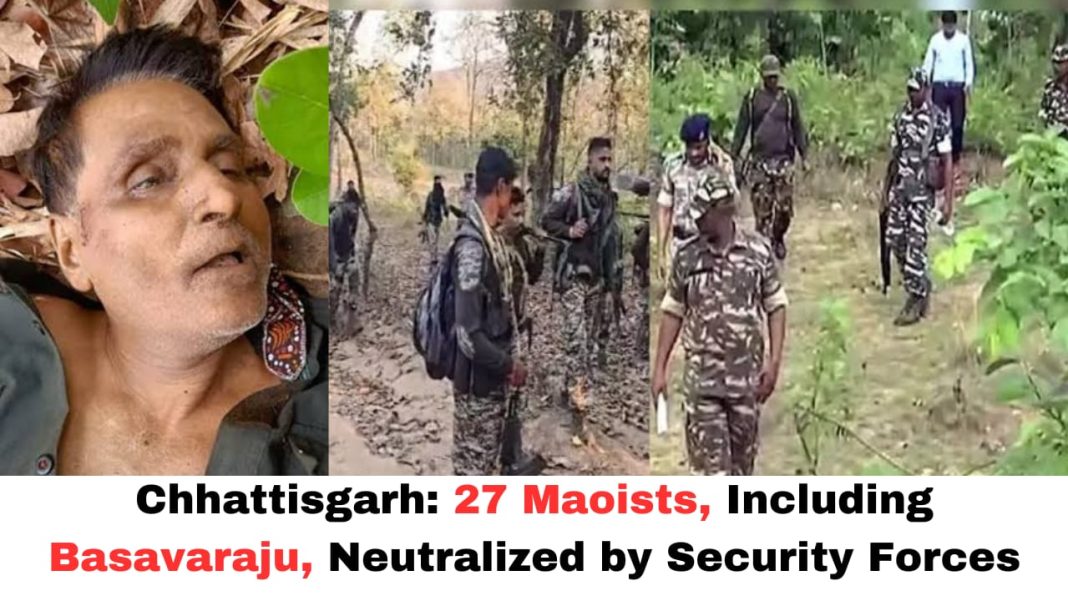Digital News Guru Chhattisgarh Desk:
On May 21, 2025, in Chhattisgarh, Indian security forces achieved a significant milestone in their long-standing battle against Maoist insurgency by eliminating Nambala Keshava Rao, also known as Basavaraju, the General Secretary of the Communist Party of India (Maoist). This operation, conducted in the dense forests of Abujhmarh in Chhattisgarh’s Bastar region, also resulted in the deaths of 26 other Maoist insurgents.
The Operation: A Strategic Success, Top Maoist Leader Nambala Keshava Rao Killed in Chhattisgarh Encounter
The joint operation was carried out by the District Reserve Guard (DRG), Special Task Force (STF), and the Central Reserve Police Force (CRPF). Acting on credible intelligence about the presence of high-ranking Maoist leaders in the area, the forces launched a coordinated assault in the early hours of May 21. The encounter lasted several hours, culminating in the deaths of 27 insurgents, including Rao.

Union Home Minister Amit Shah hailed the operation as a “landmark achievement,” emphasizing that it marked the first time in over three decades that a general secretary-level leader of the CPI (Maoist) had been neutralized. Prime Minister Narendra Modi also praised the security forces for their success, reaffirming the government’s commitment to eradicating Maoist insurgency and restoring peace in affected regions.
Nambala Keshava Rao: The Man Behind the Movement
Born in 1955 in Jiyannapet village of Srikakulam district, Andhra Pradesh, Rao was an alumnus of the National Institute of Technology, Warangal. He was actively involved in left-wing student politics during his college years and joined the Naxalite movement in the 1970s. Over the decades, he rose through the ranks to become the General Secretary of the CPI (Maoist) in 2018, following the resignation of Muppala Lakshmana Rao, also known as Ganapathy.
Rao was known for his strategic acumen and expertise in guerrilla warfare, particularly in the use of improvised explosive devices (IEDs). He was the mastermind behind several deadly attacks, including the 2010 Dantewada ambush that killed 76 CRPF personnel and the 2013 Jheeram Ghati massacre, which claimed the lives of senior Congress leaders.
At the time of his death, Rao had a bounty of Rs 1.5 crore on his head and was listed among the most wanted criminals by the National Investigation Agency.
Impact on the Maoist Insurgency
The elimination of Rao is considered a major blow to the Maoist insurgency, which has been active in India since 1967. His death is expected to create a leadership vacuum within the CPI (Maoist), potentially leading to internal power struggles and a decline in coordinated attacks. Analysts suggest that the insurgency is nearing its end, with operational capabilities significantly diminished due to ongoing security operations and the loss of key leaders.

The government’s strategy, including operations like “Operation Black Forest,” has further weakened the insurgency, leading to numerous Maoist deaths, arrests, and surrenders. Home Minister Amit Shah reaffirmed the government’s goal of a Naxal-free India by March 2026.
The Role of the District Reserve Guard
The District Reserve Guard (DRG), a specialized unit of the Chhattisgarh Police formed in 2008, played a crucial role in the operation. Comprising local recruits familiar with the terrain and culture, the DRG has been instrumental in counter-insurgency efforts in the region. Their involvement in this operation underscores the effectiveness of localized forces in combating insurgency.
Future Outlook
While the death of Rao marks a significant victory, experts caution that the Maoist insurgency may not be entirely eradicated. Remaining leaders and cadres could attempt to regroup or carry out retaliatory attacks. Continuous intelligence gathering, community engagement, and development initiatives are essential to prevent the resurgence of insurgent activities.
The government is expected to continue its dual approach of security operations and socio-economic development to address the root causes of the insurgency. Efforts to improve infrastructure, education, and employment opportunities in affected regions are crucial for long-term peace and stability.

Conclusion
The successful operation against Nambala Keshava Rao signifies a turning point in India’s fight against Maoist insurgency. It reflects the effectiveness of coordinated security efforts and the importance of local intelligence and participation. While challenges remain, this achievement brings the nation closer to its goal of a Naxal-free India.
You May Also Read: National Anti-Terrorism Day 2025: India’s Unified Stand Against Terrorism Amidst Operation Sindoor








